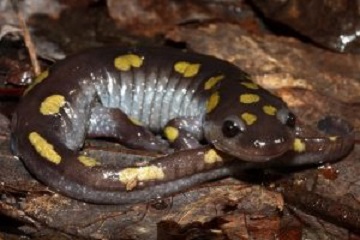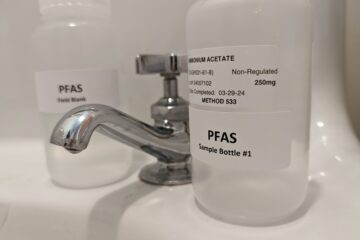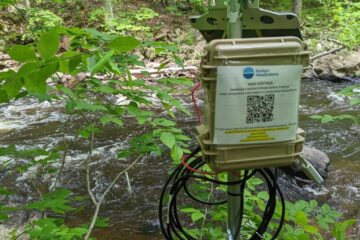
Spotted Salamander (photo: Andrew Hoffman)
Who should get credit for clean, pure water in our rivers, streams and underground aquifers? Much of the thanks should go to natural ecosystems, especially forests and wetlands that absorb and filter rainwater.
These forests and wetlands – as well as their native plants and animals – provide valuable “ecosystem services” in the upper Raritan River basin and beyond.
This spring, Raritan Headwaters Association (RHA) will launch three long term initiatives to monitor and protect aquatic biodiversity: documenting vernal pools, surveying salamanders in local streams, and assessing connectivity of our streams and wetlands. All three initiatives were piloted last spring and summer.
Protecting watershed’s animals and plants helps water quality
“If the natural environment didn’t provide ecosystem services to keep our water clean, humans would have to pay billions of dollars for manmade systems to do the same job,” said Dr. Kristi MacDonald, director of science for Raritan Headwaters. “We want to make sure the organisms that do the work are protected.”
Major threats to biodiversity include:
- Habitat loss or degradation
- Loss of connectivity
- Invasive species
- Climate change
- Development
- Roads
- Poor logging practices
- Off-road vehicles
- Illegal collection of amphibians and reptiles
- Holes in regulatory protection
- Lack of monitoring data
According to Dr. MacDonald, certain microorganisms, fungi, plants and animals help filter impurities from water. “If ecosystems are not functioning due to loss of biodiversity, our drinking water supply is jeopardized,” she said.
Vernal Pools
Vernal pools are ephemeral, isolated wetlands without fish living in them. Many are woodland pools but they can also be found in more open habitats such as meadows. Due to the lack of predatory fish, they are breeding hotspots for a host of amphibians, including wood frogs, and spotted, Jefferson and marbled salamanders. They are also used by reptiles, birds, mammals and arthropods.
The first late winter-early spring rains harken the movement of spotted and Jefferson salamanders, wood frogs, toads and a variety of other amphibians from their upland resting places to their breeding wetlands known as vernal pools, where they will lay millions of eggs. These species often suffer high mortality on roads, which they often cross en masse on cold rainy nights as they return to the same pool each year. In some places, the roads are closed on those evenings or volunteers are ready to help amphibians across the road and document their numbers.
According to Dr. MacDonald, mapping done by the New Jersey Department of Environmental Protection (NJDEP) indicates that there may be at least 461 vernal pools within the North and South Branch Raritan watershed. However, only 121 of them have been confirmed vernal pools based on a list of criteria. Because vernal pools are typically small, most are less than .25 acre, they miss the critical wetland protections afforded wetlands that are greater than or equal to 1 acre.
Raritan Headwaters will visit each potential location – not once, but four times, as required by the NJDEP – to learn what conditions exist throughout the seasons. If vernal pools are found, they have water for at least 2 months of the year, and are documented as breeding sites for amphibians, they are eligible for special state protections.
Salamander Surveys
This spring, RHA staff and volunteers will continue to survey salamander populations at 68 stream sites already being monitored for “benthic macroinvertebrates,” small creatures that live in river and stream beds.
Just as the presence of certain benthic macroinvertebrates is a measure of water and habitat quality, so, too, is salamander presence and abundance. In our region, streams are home to mainly the two-lined salamander, northern red salamander, northern dusky salamander, and northern long-tailed salamander, a threatened species in New Jersey.
“Salamanders are an important taxonomic group in headwater streams, where they play the role of top predators and also prey,” explained Dr. MacDonald.
Habitat Connectivity
To ensure biodiversity in the upper Raritan River watershed, important wildlife habitats must stay connected.
For example, many salamanders and frogs spend the winter in upland habitats, but migrate to wetlands and vernal pools on lower ground to breed. If their path is blocked by roads, bridges and culverts, many can be killed or fail to reach their breeding places. In addition, poorly designed or structurally deteriorating culverts, bridges and dams can disrupt the connectivity of streams and prevent movement of fish and other aquatic organisms.
Starting this spring, RHA will continue to participate in the North American Aquatic Connectivity Collaborative (NAACC) and assess whether culverts, bridges and other crossings are interfering with movement of aquatic and terrestrial organisms. RHA will also map wetlands and wetland complexes in order to ensure connections are maintained.
Volunteers Needed
“The goal of these three projects is to share information on aquatic biodiversity and local habitat needs with municipal officials, the NJ Department of Environmental Protection and residents to help plan for improved protection of our ecosystems,” said Dr. MacDonald.
To help with these projects and others – including stream monitoring, tree plantings and stream cleanups – Raritan Headwaters is seeking volunteer citizen scientists. To volunteer with RHA, contact Trish McGuire, volunteer coordinator, at tmcguire@raritanheadwaters.org or 908-234-1852 ext. 324.



